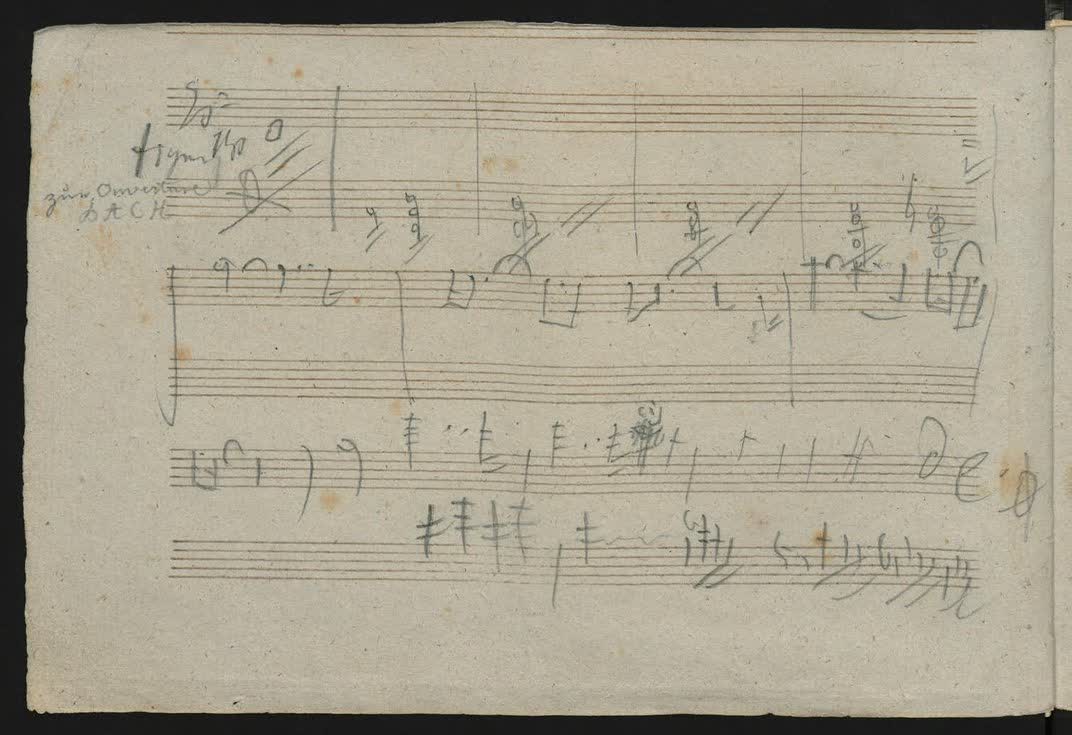Music scholars and computer scientists completed Beethoven's Tenth Symphony aided by machine learning
What but happened? Artificial intelligence has completed Beethoven'south 10th Symphony—or at least, what that piece of music could have sounded similar had he finished it. A globe premiere of the music will take place on October 9, 2022.
In 1817, the Royal Philharmonic Guild in London commissioned Ludwig Von Beethoven to etch his 9th and Tenth symphonies. He completed the Ninth Symphony, which concludes the fourth movement with the all too familiar "Ode to Joy" (below). Due to failing health and his subsequent expiry in 1827, he never completed his Tenth Symphony. All that remains of that piece of work is some scrawled musical sketches.
The Karajan Plant partnered with a group of scientists from AI startup Playform led past Ahmed Elgammal. The team spent two years training an AI model using Beethoven'south complete works, the 10th Symphony sketches he left behind, and what is known about his methods of composing music.
Elgammal tapped Walter Werzowa, the mind backside Intel's bong jingle, to merge what Beethoven left behind with the AI-constructed music. Computational music expert Mark Gotham led efforts to transcribe the centuries-old sketches and process Beethoven's unabridged work to train machine learning algorithms. Harvard musicologist Robert Levin, who had previously completed several musical compositions from Mozart and Bach, also helped on the project.
"In a large room with a piano, a blackboard and a stack of Beethoven's sketchbooks spanning most of his known works, we talked nigh how fragments could exist turned into a complete slice of music and how AI could help solve this puzzle, while still remaining faithful to Beethoven'south process and vision," Elgammal said.
The homo side of the projection required intensive report of the Tenth Symphony sketches to make up one's mind what Beethoven's intentions were for the piece. Using the composer'southward completed works as a template, they puzzled out which of Beethoven'southward incomplete musical phrases belonged in which of the four movements of the symphony.
The AI's task was to figure out how to fill in the gaps. It needed to accept very short musical phrases of just a few notes and expand them into longer, more elaborate structures. It did this past learning how Beethoven built his Fifth Symphony on a simple four-notation motif. It also needed to understand the musical grade of each expanded phrase—scherzo, trio, or fugue—to ensure it went into the correct motion.
As the project went on, the computer scientists plant that the AI would have to be responsible for a lot more than.
"The to-do list grew: We had to teach the AI how to have a melodic line and harmonize it," said Elgammal. "The AI needed to learn how to bridge 2 sections of music together. And we realized the AI had to be able to compose a coda, which is a segment that brings a section of a piece of music to its conclusion."
It also had to determine what instruments would play which parts, and it had to do all of this in a way that the nifty composer may have done information technology.
The squad held its first test in front end of journalists and, more chiefly, music scholars and Beethoven experts. It asked them to see if they could figure out where the composer'south work ended, and the AI connected. The music experts were stumped and unable to tell which parts were composed by the AI.
Elgammal performed a second test in front of experts, some of whom were familiar with Beethoven's Tenth Symphony sketches. Only those who had "intimate knowledge" of the incomplete works were able to pick out the AI-synthetic parts. The exam was enough to conclude that the algorithms had done a expert plenty job completing Beethoven'south 10th.
Beethoven's Tenth Symphony will be released to the public on October ten later on its debut functioning in Bonn, Federal republic of germany. You tin get a taste of how well the AI constructed the piece from this short selection provided past Smithsonian Magazine.
Paradigm credit: Perrant (CC BY-SA iii.0)
Source: https://www.techspot.com/news/91493-music-scholars-computer-scientists-completed-beethoven-tenth-symphony.html
Posted by: monsonfrawing69.blogspot.com



0 Response to "Music scholars and computer scientists completed Beethoven's Tenth Symphony aided by machine learning"
Post a Comment